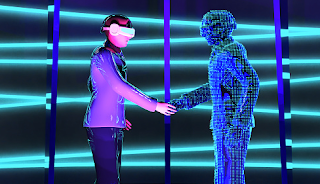Before moving please go through the ... -
1. How did holograms come into existence and what is it actually?
2. Top 5 benefits of using holograms in your business.
3. How an Augmented Reality device is built.
"A stick of ram for hologram!"
Three-dimensional video chat and holograms, or projections that mimic them, are two pieces of technology holding a lot of promise for our new era of remote work. These technologies are being developed by both large and small IT companies. But thus far, predictions about the impending arrival of fluid 3-D video conferencing have turned out to be premature. Things are different this time, at least according to Cisco Systems Inc. Holographic communication will soon be possible and practical, according to the maker of networking equipment, who believes that the necessary technical underpinnings are now in place. Today's headsets have the sufficient processing power, and networks provide sufficient bandwidth with low latency.
If you are thinking of many alternatives to the hologram. Yes, there is an alternative and that is nothing but AR ( Augmented Reality). There are many pros and cons to this.
Pros- 1. The best part of this is cheap
2. Easy to handle, understand and use.
3. compatible with most of the devices to use.
4. Developers can make changes by programming it.
5. Futuristic and makes the image quality excellent and realistic
6. Easy to port (Portable), don't need many things to generate the image
7. No high requirements for hardware.
Things required to view and create an AR image - Smartphone, Programming skills (c++), Software (AR Core, Unity)
Cons - 1. Without the smartphone or other computer-operated device, the AR won't be running
2. One mistake/ error in the image the total project gets dull.
3. For high-quality AR processes like 1. live AR chat, 2. AR gaming and etc requires a team of developers to develop and this makes the creator spend a lot compared to holograms
4. AR image is not DIY like a hologram.
5. Compared to holograms, they don't feel the object is real; they just make you feel it is real but can be identified.
Things required to create a holographic image - Computer (Image creating and for servers), Laser emitter, Mirror adjustment, Cameras, and Mirrors.
As we are discussing how holograms can change technology, this obviously includes the live conferencing in WFH jobs using holograms. During this situation, the need for AR is of no use as it requires smartphones to view, this will just give the users the experience of Google meet which is not good as it will look old school. But using holograms we can make the employees come in one place that looks real but will not be accurate. With the help of ciscos servers and bandwidth, we can absolutely make this possible. without the major glitch. Now the question comes how this is actually possible? Making live conferences in holograms looks difficult as every motion of people should be captured, registered, and displayed all at the same time. So how is that possible, till now we have made holograms of recorded objects and not live ones. Looking at this we can apply John Logie Baird's method used in creating television. Which we will be discussing in the next post.

1 Comments
Holograms are set to revolutionize remote work, enabling realistic 3D video conferencing. Unlike AR, which requires external devices, holograms create immersive, lifelike interactions. With advancements in processing power and network bandwidth, companies like Cisco are making live holographic meetings possible. This technology could redefine virtual collaboration, making remote communication feel as real as face-to-face interactions.
_________________________________
gadget salvation